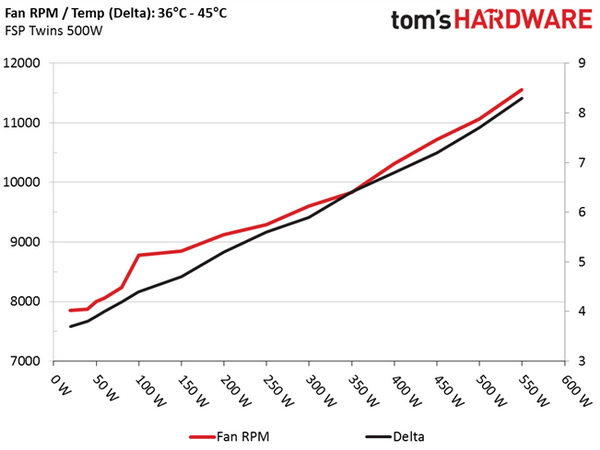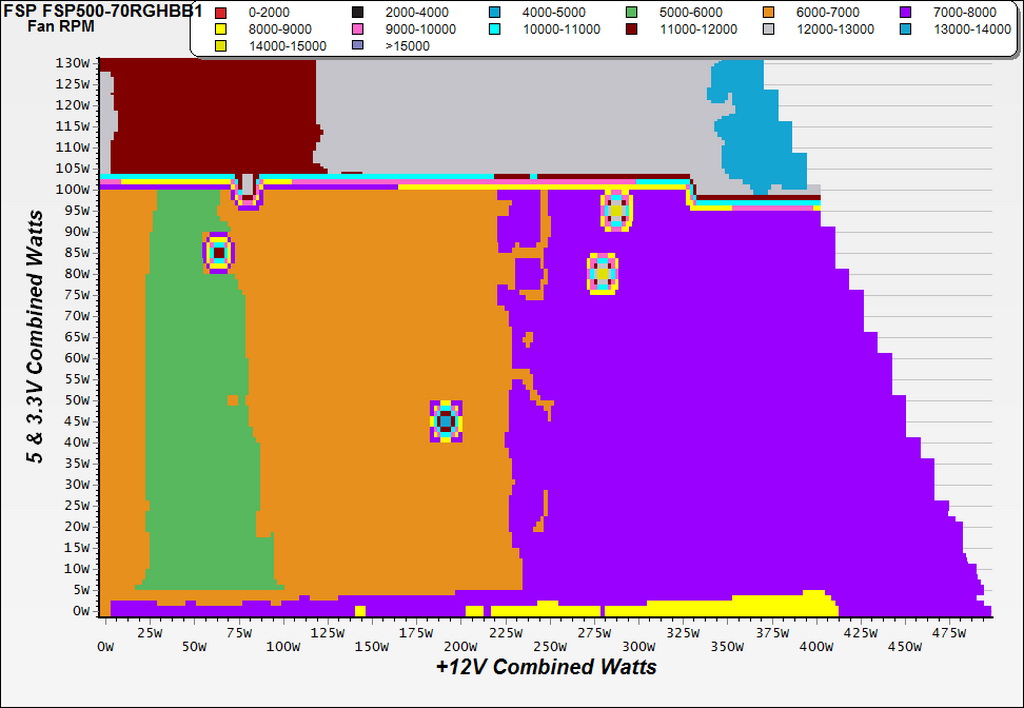FSP Twins 500W Redundant PSU Review
The FSP Twins series combines the usability of a normal ATX PSU and the advanced features of a redundant server unit. The Twins 500W we're evaluating today addresses users that need an ultra-reliable PSU and are willing to pay for it.
Why you can trust Tom's Hardware
Efficiency, Temperature, And Noise
Efficiency
Our efficiency testing procedure is detailed here.
Using results from the previous page, we plotted a chart showing the Twins 500W's efficiency at low loads, and loads from 10 to 110 percent of its maximum-rated capacity.
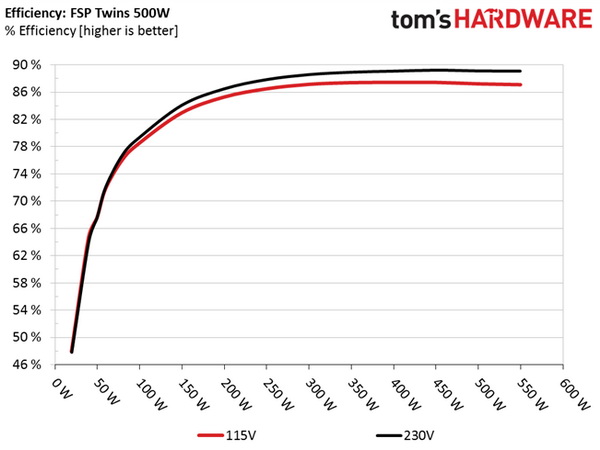
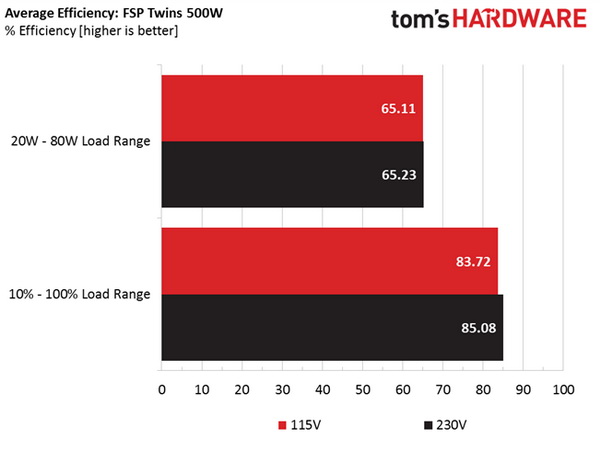
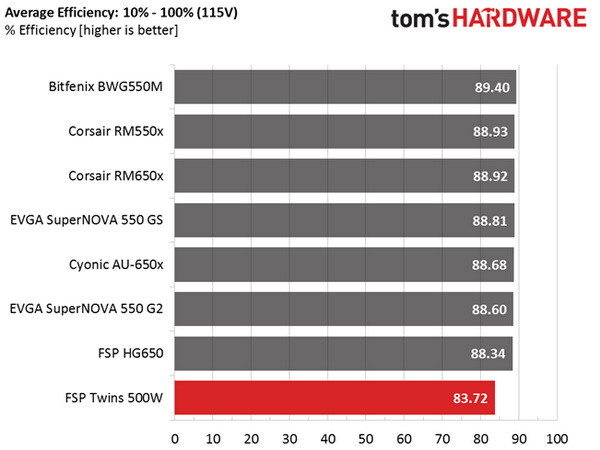
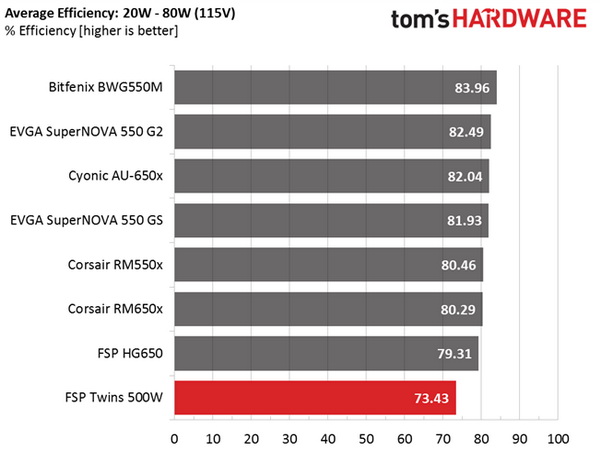
Under light loads, the combined power loss of both modules leads to low efficiency. If there was an option to completely deactivate one of the modules instead of having both of them working in parallel, those figures would be significantly better.
The main advantage of having both modules active at the same time is improved efficiency under higher loads. They also endure less stress, since only a fraction of their maximum power output is delivered.
Efficiency At Low Loads
In the following tests, we measure the Twins 500W's efficiency at loads significantly lower than 10 percent of its maximum capacity (the lowest load the 80 PLUS standard measures). The loads we dialed were 20, 40, 60, and 80W. This is important for representing when a PC is idle, with power-saving features turned on.
| Test # | 12V | 5V | 3.3V | 5VSB | DC/AC (Watts) | Efficiency | Fan Speed | Fan Noise | PF/AC Volts |
|---|---|---|---|---|---|---|---|---|---|
| 1 | 1.208A | 0.491A | 0.479A | 0.195A | 19.64 | 47.926% | 7870 RPM | 50.6 dB(A) | 0.738 |
| 12.073V | 5.023V | 3.328V | 5.105V | 40.98 | 115.1V | ||||
| 2 | 2.447A | 0.991A | 0.991A | 0.391A | 39.77 | 64.635% | 7853 RPM | 50.8 dB(A) | 0.919 |
| 12.062V | 5.015V | 3.321V | 5.087V | 61.53 | 115.0V | ||||
| 3 | 3.686A | 1.487A | 1.505A | 5.070A | 59.85 | 71.806% | 8002 RPM | 52.2 dB(A) | 0.949 |
| 12.052V | 5.008V | 3.318V | 5.070V | 83.35 | 115.0V | ||||
| 4 | 4.915A | 1.999A | 1.989A | 0.790A | 79.76 | 76.071% | 8062 RPM | 52.2 dB(A) | 0.958 |
| 12.042V | 5.000V | 3.313V | 5.055V | 104.85 | 115.1V |
Our measured efficiency is disappointing under light loads. To make matters worse, the fans exceed 50 dB(A).
FSP Guardian Screenshots
You'll find screenshots of FSP's Guardian software below, which we captured under light loads.
Get Tom's Hardware's best news and in-depth reviews, straight to your inbox.
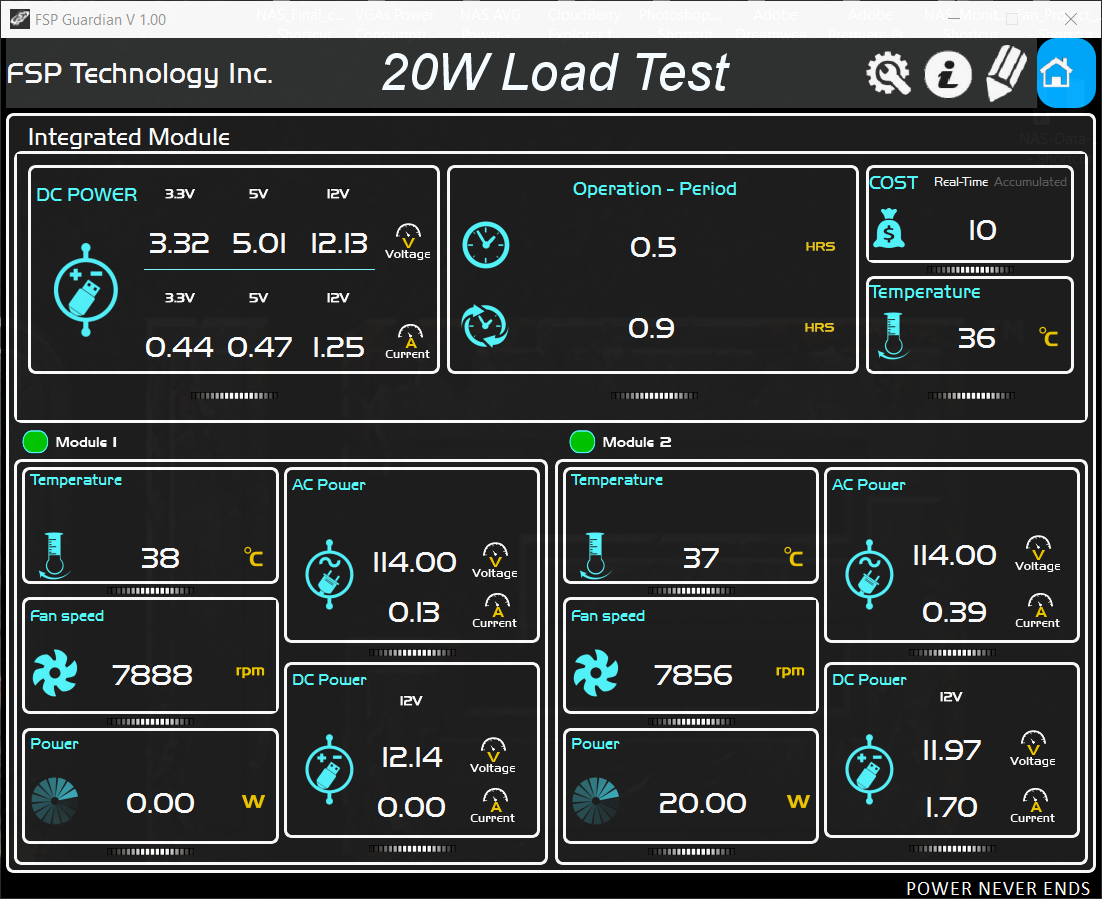
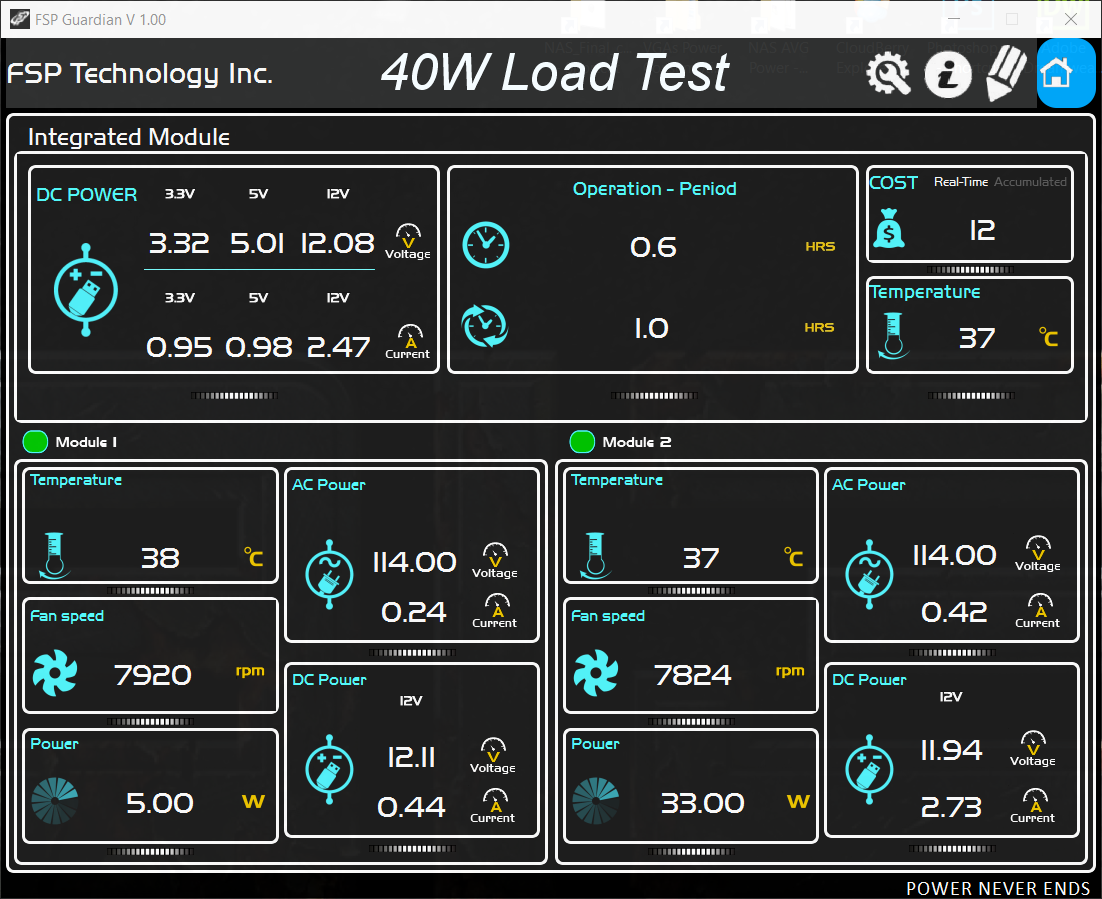


5VSB Efficiency
The ATX specification states that 5VSB standby supply efficiency should be as high as possible, recommending 50 percent or higher with 100mA of load, 60 percent or higher with 250mA of load, and 70 percent or higher with 1A or more of load.
We take four measurements: one each at 100, 250, and 1000mA, and one with the full load the 5VSB rail can handle.
| Test # | 5VSB | DC/AC (Watts) | Efficiency | PF/AC Volts |
|---|---|---|---|---|
| 1 | 0.101A | 0.520 | 22.318% | 0.165 |
| 5.133V | 2.330 | 115.1V | ||
| 2 | 0.252A | 1.290 | 39.329% | 0.213 |
| 5.117V | 3.280 | 115.1V | ||
| 3 | 1.002A | 5.070 | 61.905% | 0.357 |
| 5.062V | 8.190 | 115.1V | ||
| 4 | 3.002A | 14.900 | 66.726% | 0.474 |
| 4.964V | 22.330 | 115.1V |
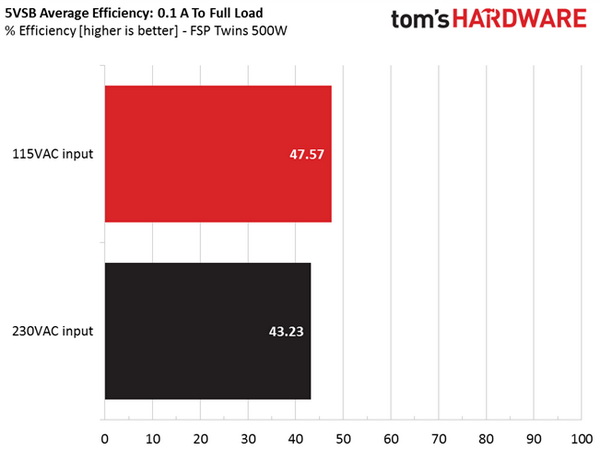
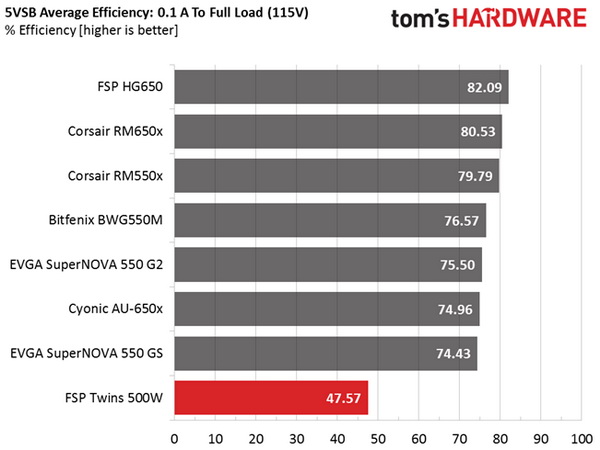
Having both 5VSB circuits operating in parallel prevents high efficiency scores, as you can see in the table above.
Power Consumption In Idle And Standby
In the table below, you'll find the power consumption and voltage values of all rails (except -12V) when the PSU is idle (powered on, but without any load on its rails), and the power consumption when the PSU is in standby mode (without any load, at 5VSB).
| Mode | 12V | 5V | 3.3V | 5VSB | Watts | PF/AC Volts |
|---|---|---|---|---|---|---|
| Idle | 12.080V | 5.029V | 3.330V | 5.146V | 22.140 | 0.670 |
| 115.1V | ||||||
| Standby | 1.710 | 0.127 | ||||
| 115.1V |
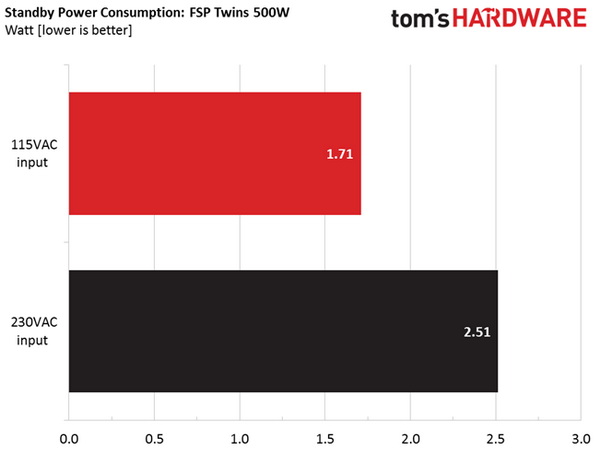
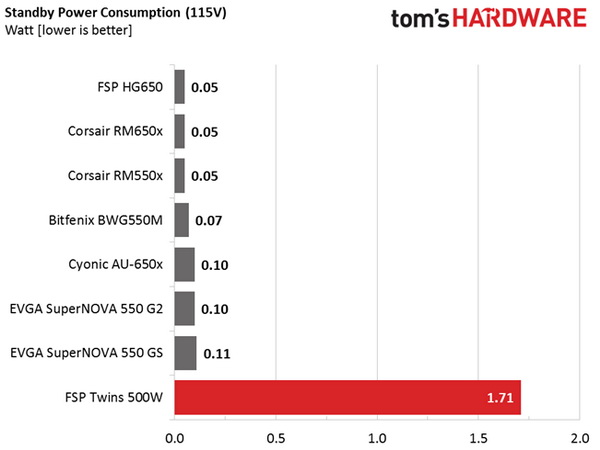
Phantom power increases, and this PSU is way above the ErP Lot 6 2013 directive's maximum allowed 0.5W.
Fan RPM, Delta Temperature, And Output Noise
Our mixed noise testing is described in detail here.
The first chart below illustrates the cooling fan's speed (in RPM), and the delta between input and output temperature. The results were obtained at 36°C (96.8°F) to 45°C (113°F) ambient temperature.
The next chart shows the cooling fan's speed (again, in RPM) and output noise. We measured acoustics from one meter away, inside a small, custom-made anechoic chamber with internals completely covered in sound-proofing material (be quiet! Noise Absorber kit). Background noise inside the chamber was below 18 dB(A) during testing, and the results were obtained with the PSU operating at 36°C (96.8°F) to 45°C (113°F) ambient temperature.
The fans inside of the power modules generate a bearing noise, which is responsible for this strange-looking graph.
The following graph illustrates the fan output noise over the PSU's operating range. The same conditions of the above graph apply to our measurements, though the ambient temperature was between at 28°C (82.4°F) to 30°C (86°F).
This definitely isn't a silent PSU, as you can see in the graph above. Even under low load on the +12V rail, fans in the modules spin very quickly once the load on the DC-DC converters exceeds a combined 100W. Fortunately, most real-world workloads won't stress the minor rails as much as we do.
The last graph illustrates the fan noise over the PSU's operating range. The same conditions of the above graph apply to our measurements.
The fans spin quickly, even under light loads. This is necessary, given their small diameter, to provide sufficient airflow.
Current page: Efficiency, Temperature, And Noise
Prev Page Load Regulation, Hold-Up Time, And Inrush Current Next Page Protection Features And Transition Time
Aris Mpitziopoulos is a contributing editor at Tom's Hardware, covering PSUs.
-
shrapnel_indie ReplyPros
Full power at 45°CAll cables are fixed, and because this is a server-like product, its maximum operating temperature for continuous full power delivery is 50°C.
Please explain to me why these numbers don't seem to match up properly. (THB, I may have missed it.)
-
dstarr3 I really wonder what a consumer could possibly want this for. What is an ordinary consumer doing that they absolutely cannot risk any downtime whatsoever on their rig?Reply -
nzalog I know freenas can be configured to work faster if you can for sure trust the system from not having RAM errors (covered by ECC) and if you can guarantee there is no unexpected shutdown (covered by dual power and ups). However the reliable power is not really required because a SSD as an SLOG device will cover for it, but then the SSD becomes the bottleneck for writes.Reply -
firefoxx04 I build several file servers a month for clients. Low end enough to where pre built solutions are not an option. This power supply would be a good fit but it is useless, imo, without some sort of email alert option. Maybe I missed that?Reply
When I deploy file servers for clients, I always setup some sort of alert system for raid failures so I can fix the problem. What is the point of redundancy if the user has no idea a problem has occurred? Yes i know that this PSU makes a "loud buzzer noise" but I cant have that either. The user needs to continue to use the system and they cannot if it is screaming 100% of the time.
Send me an email alert. Its easy to implement. -
Rookie_MIB One thing I'm curious about - what if one unit does fail? Are they bog-standard replacement parts where you can go and buy a similar hot swap redundant power supply or is the system proprietary. If it's the latter, then I don't see many people lining up for this one...Reply -
apache_lives A PSU is but one part of a "reliable" machine, to me this will not increase up time or do anything of any value, seems more like a "makes me feel better" part.Reply -
Aris_Mp about the first comment, the PSU is certified for up to 50C ambient full power delivery, but I choose to test up to 45C every PSU that passed from my test bench (since I also have to evaluate 40C rated units and I need to keep the same conditions for all).Reply -
shrapnel_indie Reply19144735 said:about the first comment, the PSU is certified for up to 50C ambient full power delivery, but I choose to test up to 45C every PSU that passed from my test bench (since I also have to evaluate 40C rated units and I need to keep the same conditions for all).
While I'm glad for that, It's also nice to know if a unit rated at 50°C operation will deliver on its "promise" though. (If you exceed the "promised" rating, like the 40°C rated units @ 45, well, it delivered on its promise and then some.)
-
Pompompaihn Newegg has several server chassis for sale that come WITH redundant 500w+ PSUs for less money than just this power supply. Given that the market is low end commercial/prosumer, and it's not going to be for gaming or HTPC, why wouldn't you just buy the whole thing for cheaper?Reply
